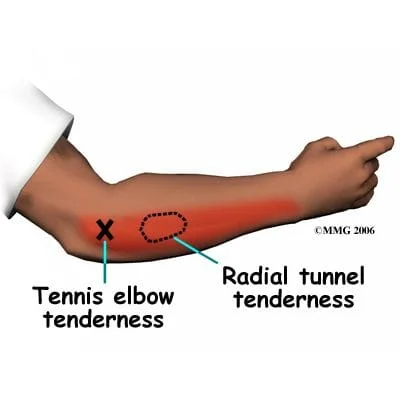If you've encountered forearm and elbow pain, our Dallas Forth Worth Radial Tunnel Syndrome Treatment might help. Dr. Pedro Loredo is a hand specialist serving the Dallas and Fort Worth, TX area. Call now for more information about treatment options for your damaged elbow.
What is Radial Tunnel Syndrome?

What Are the Symptoms of Radial Tunnel Syndrome?
Symptoms of Radial Tunnel Syndrome may include the following:
- Tenderness and pain on the outside of the elbow
- Tenderness and pain in the forearm
- Muscle weakness in the wrist and/or fingers
- Pain which gets worse when twisting or turning the palm of the hand upward, bending the wrist backward, or grasping an object with a stiff wrist or straightened elbow
Dr. Loredo’s Approach to Treating Radial Tunnel Syndrome
Non-Surgical Treatment Options
Depending on the severity of the condition, Dr. Loredo may attempt to treat non-surgically before recommending surgery. Non-surgical treatments include:
- Anti-inflammatory medications (NSAIDs) to relieve inflammation and pain
- Steroid injections to reduce swelling and pain
- The use of a splint to support the elbow
- Resting and icing the affected area(s)
- Physical therapy
Surgical Treatment Options
In the event that non-surgical treatment is ineffective and the patient is a candidate, Dr. Loredo will opt for minimally-invasive surgery to decompress the radial nerve.
What Can I Expect After Surgery?
Dr. Loredo uses the most advanced, minimally-invasive techniques available. Most patients enjoy instantaneous relief from pain with little to no post-operative downtime.
Frequently Asked Questions
Is Radial Tunnel Syndrome essentially the same thing as Tennis Elbow?
No. Although the two conditions both involve nerves in the elbow and have some symptoms in common, they are different and require different treatment.

With Tennis Elbow, the pain starts where the tendon attaches to the bone on the outside of the elbow. With Radial Tunnel Syndrome, the pain is centered about two inches further down the arm where the radial nerve meets the forearm muscle. Additionally, the pain associated with Radial Tunnel Syndrome tends to be more of an ache and feeling of fatigue in the forearm muscles.
Is numbness or loss of sensation associated with Radial Tunnel Syndrome?
No. The sensory component of the radial nerve branches off before it reaches the radial tunnel and therefore numbness or loss of sensation are not associated with Radial Tunnel Syndrome.
Contact the Loredo Hand Care Institute
If you are experiencing any of the symptoms associated with Radial Tunnel Syndrome or would like to learn more about our practice in the Dallas area, please contact us today.
